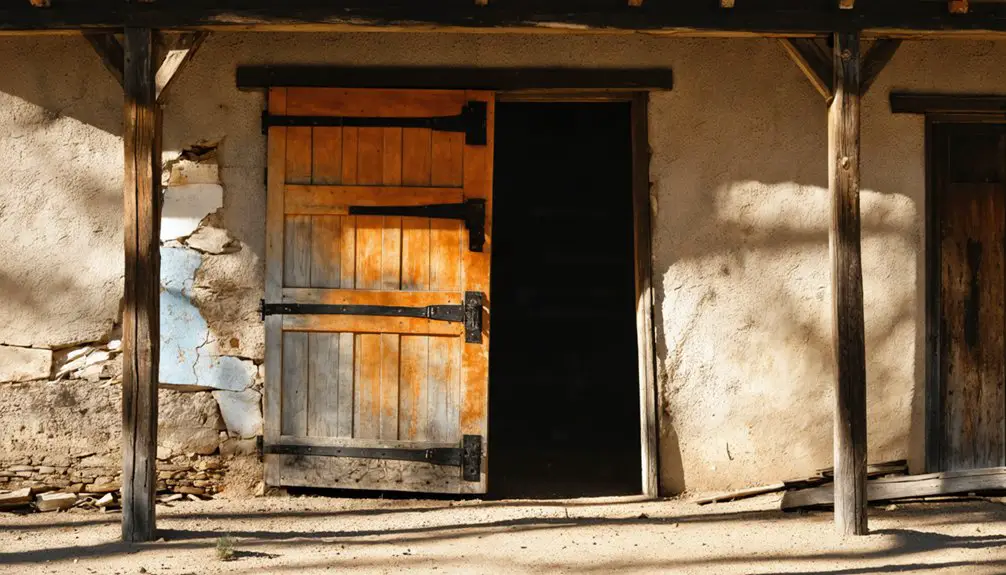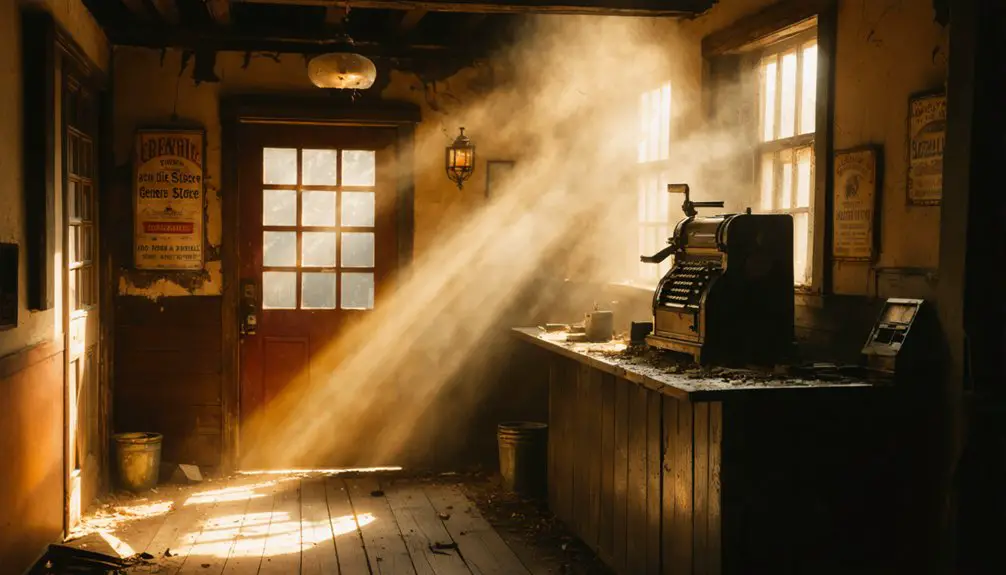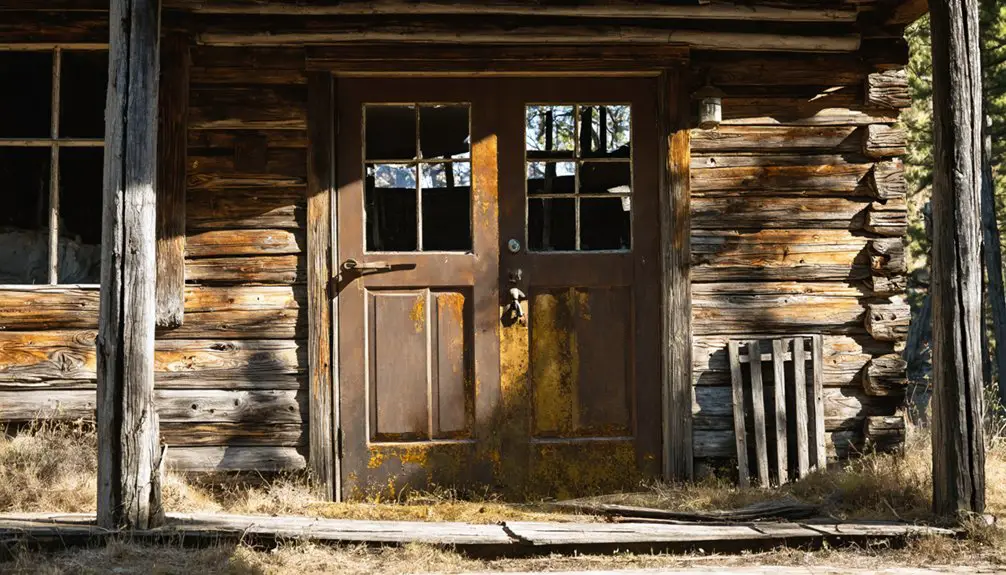You’ll discover Mogollon nestled in New Mexico’s Gila Mountains, where prospectors struck gold and silver in the 1870s. By 1909, this bustling mining town boasted five saloons, two hotels, and a population of 6,000 residents. Despite yielding over $20 million in precious metals, the town faced devastating fires, floods, and economic challenges. Today, nearly 100 historic buildings remain, offering a remarkable window into one of America’s best-preserved mining communities.
Key Takeaways
- Mogollon is a historic mining town in New Mexico that produced over $20 million in precious metals during its peak mining years.
- The town reached a peak population of 6,000 residents in the 1890s but now maintains only about 15 full-time residents.
- Nearly 100 historic buildings remain, including the Silver Creek Inn, and are listed on the National Register of Historic Places.
- Natural disasters, including fires and floods, along with the Spanish Flu epidemic of 1918, contributed to the town’s decline.
- The ghost town is accessible to tourists from May to October, featuring a museum with mining artifacts and preserved historic structures.
The Birth of a Mining Frontier
As Sergeant James C. Cooney discovered a rich gold vein in the Gila Mountains during the 1870s, he set in motion the birth of what would become one of New Mexico’s most notorious mining towns.
You’ll find the first signs of permanent settlement emerged when John Eberle built his cabin in 1889, marking the beginning of organized mining techniques along Silver Creek. The town quickly grew to include five bustling saloons and two hotels by 1909.
The town’s infrastructure quickly took shape with a jail and post office by 1890, followed by a school in 1892. The area became so significant that it required a disambiguation page to distinguish it from other places named Mogollon.
Through community resilience, Mogollon absorbed residents from nearby Cooney and influenced the growth of neighboring settlements like Glenwood, Gila, and Cliff.
Despite the constant threat of stagecoach robberies along the Silver City route, the town persevered, though Wells Fargo agents eventually captured the persistent bandit who’d struck 23 times.
Tales From the Silver and Gold Rush
As you explore Mogollon’s mining heyday, you’ll discover that its mines yielded an astounding $20 million in precious metals, with silver accounting for two-thirds of this wealth.
By 1915, the booming operations employed thousands of miners working dangerous conditions in aptly named mines like Little Fanny and Silver Queen, while supporting a monthly payroll of $75,000.
Through the perils of dust-filled tunnels and Black Lung disease, determined prospectors persevered, though few managed to work longer than three years in the hazardous conditions that defined this legendary mining town. Despite these risks, the allure of riches kept drawing new miners to the area.
The town’s mining operations achieved remarkable efficiency after installing electric fuel generators, which significantly reduced energy costs and improved overall production.
Riches From The Mountains
The rich mineral deposits of Mogollon yielded over 18 million ounces of silver between the 1880s and early 1900s, representing a quarter of New Mexico’s total silver production.
Mining techniques focused on extracting both silver and gold, with total mineral production valued at $20 million, two-thirds coming from silver ore extraction.
You’ll find that by 1913, Mogollon’s mines were producing an impressive $1.5 million in precious metals yearly, accounting for 40% of New Mexico’s output.
The mining payroll reached $75,000 monthly by 1915, supporting 1,500 residents.
Eight-horse teams navigated treacherous mountain roads, rising 2,000 feet in just seven miles, to transport ore to Silver City’s railhead.
Despite hazardous conditions and frequent natural disasters, miners persisted, driven by the substantial profits from these mountain riches.
Prospector Dreams And Legends
Dark tales and ghostly legends permeate Mogollon’s rich mining history, beginning with the violent death of its first citizen, James C. Cooney, at the hands of Apache chief Victorio in 1880. His brother Michael later died searching for a lost gold mine in 1914, adding to the prospector legends that define this mining town.
You’ll find stories of lost mines and hidden treasures everywhere in Mogollon, where over 18 million ounces of silver were extracted. The town’s mines produced an incredible twenty million dollars in precious metals during their operation.
Treasure myths speak of prospectors who hid gold caches in the wilderness, while tales of claim jumpers and stagecoach robbers add to the outlaw mystique. The notorious Bloated Goat tavern became a hub for sharing these wild tales of prospector adventures and near misses.
Despite the town’s massive mineral wealth, many miners died poor, battling harsh conditions, black lung disease, and dangerous solo expeditions into the rugged terrain, forever chasing dreams of striking it rich.
Wild Mining Town Life
Life in Mogollon transformed rapidly from a modest tent settlement into a bustling boomtown between the 1880s and early 1900s, with John Eberle’s cabin marking the first permanent structure in 1889. The town earned its reputation as one of the wildest mining towns in the West.
As mining culture flourished, you’d have found a growing town with essential services – a jail and post office by 1890, followed by a school serving 300 students.
By 1915, the town boasted electricity, water, and telephone services, supporting a population of 1,500 residents.
Strong community bonds formed as miners faced dangerous working conditions, with most leaving within three years due to black lung disease.
The monthly payroll of $75,000 fueled local businesses, while challenging mountain roads required up to 18 horses to transport precious ore through Silver Creek Canyon to Silver City’s railhead.
Life in a Bustling Mountain Town
When you visited Mogollon during its peak years between 1900-1915, you’d find a bustling mining town equipped with modern amenities like electricity, telephones, and entertainment venues including saloons and a theater.
You’d witness the tough daily rhythms of miners who, despite their modest means, fostered a strong community spirit through celebrations like Cinco de Mayo. The town thrived on its rich deposits of gold and silver that drew thousands of residents to the area.
You’d also experience the harsh realities of mountain life, as the town’s residents faced ongoing challenges from Apache raids, natural disasters, and epidemics, including the devastating 1918 Spanish Flu. The Little Fanny Mine became the town’s largest operation but ultimately closed due to poor air conditions.
Daily Mining Town Rhythms
During the peak mining years of Mogollon, up to 6,000 miners worked the local mines, creating a bustling rhythm of activity that defined this mountain settlement.
You’d find miners heading to operations like the Little Fanny mine, where water sprays helped protect them from deadly dust during quartz breaking. Daily routines revolved around the mines’ demands, with teams of horses hauling ore along treacherous mountain roads to Silver City.
Miner camaraderie developed in the town’s five saloons and two hotels, though the harsh reality of mining life meant most workers wouldn’t survive more than three years before succumbing to illnesses like Black Lung.
You’d discover a self-contained community with essential services – from ice makers to photographers – supporting the demanding mining lifestyle that dominated Mogollon’s daily existence.
Entertainment and Social Life
Beyond the daily toil of mining life, Mogollon’s vibrant social scene centered around its five bustling saloons, where you’d find miners unwinding through gambling, storytelling, and live music. The saloons culture fostered a tight-knit community, with locals gathering to share tales of mining exploits and western folklore. During its peak in the 1890s, the town drew a population of up to 6,000 residents who contributed to its lively atmosphere.
The Silver Creek Inn served as another social hub, hosting travelers and residents alike. You could join seasonal celebrations, dances, and community events that brought everyone together despite the town’s isolation.
Communal storytelling thrived, especially when recounting famous incidents like Pancho Villa’s raid. During summer months, social activities expanded outdoors, with hunting expeditions and gatherings near prominent buildings.
Mountain Community Challenges
Despite Mogollon’s prosperity as a mining town, its mountain location created numerous challenges for residents. You’d face recurring natural disasters, including devastating fires that repeatedly destroyed wooden structures between 1894 and 1942.
Silver Creek’s flooding wreaked havoc on mines, bridges, and homes, while claiming lives in the process. The mining impacts extended beyond economic volatility – threatening local biodiversity and sacred Indigenous sites.
Though you’d have enjoyed modern amenities like electricity and telephone service by 1915, maintaining infrastructure proved difficult. Community resilience shone through as residents rebuilt with stone and adobe after fires, but isolation took its toll.
The narrow, winding mountain roads complicated access to supplies, education, and healthcare, while epidemics like the 1918 Spanish Flu hit the remote population particularly hard.
The Rise and Fall of Mogollon’s Fortune
The remarkable story of Mogollon’s fortune began in 1870 when soldier James Cooney discovered rich gold and silver veins in the mountainous terrain of New Mexico.
By the 1890s, you’d find between 3,000 and 6,000 miners working the claims, generating massive wealth that reached $1.5 million annually in precious metals by 1913.
Yet Mogollon’s prosperity came at a steep price. Mining accidents and deadly working conditions meant most miners survived only three years before succumbing to black lung disease.
The town faced repeated economic fluctuations from devastating fires and floods that destroyed infrastructure. Despite the monthly payroll of $75,000 by 1915, the town’s fortune gradually declined as rich veins depleted and metal prices shifted.
After extracting over 18 million ounces of silver, Mogollon ultimately surrendered to the harsh realities of mountain mining life.
Surviving Natural Disasters and Hardships

While Mogollon’s mineral wealth brought prosperity, nature delivered constant challenges to this remote mining settlement.
You’ll find evidence of the town’s struggles in its history of devastating fires that destroyed essential buildings and the recurring floods that swept through Silver Creek Canyon. The community’s disaster preparedness was severely tested by its isolation in the rugged Mogollon Mountains, where harsh winters and limited access complicated emergency responses.
The 1918 Spanish Flu epidemic struck particularly hard, filling the town’s cemetery with victims.
When combined with economic pressures from fluctuating metal prices and mine closures after World War II, these hardships led to significant population decline.
Yet through community rebuilding efforts, some resilient residents maintained their connection to Mogollon, preserving historic structures and adapting them for seasonal use.
Architectural Heritage and Historic Buildings
Standing as a proof of frontier mining architecture, Mogollon’s nearly 100 historic buildings showcase late 19th and early 20th-century construction techniques common to mountain mining settlements.
The town’s architectural significance earned it a spot on the National Register of Historic Places in 1987.
Mogollon’s authentic frontier mining architecture and well-preserved historic buildings made it worthy of National Register recognition.
You’ll find diverse structures throughout the district, including the two-story adobe Silver Creek Inn (formerly Mogollon House) from 1885, the Old Kelly Store, and numerous miners’ shacks.
The buildings feature thick adobe walls, heavy timber framing, and adaptations to the rugged terrain.
Despite floods and fires, preservation efforts continue to maintain these structures’ historical authenticity.
The layout follows the natural topography, with buildings combining residential and commercial spaces – a typical characteristic of frontier mining communities.
Modern-Day Ghost Town Experience

Today, visitors encountering Mogollon’s remote mountain setting will find a living ghost town occupied by roughly 15 full-time residents who serve as its caretakers.
During the warmer months from May through October, you’ll experience a blend of authentic ghost town photography opportunities alongside active seasonal tourism, with several businesses operating on weekends.
You can explore the town’s historic district, where abandoned miner shacks and mountainside structures provide compelling photo opportunities.
The Purple Onion Café, Cemetery Archives, and visitor center at the Old Kelly Store offer weekend services, while the Mogollon Museum showcases mining artifacts and period displays.
You’ll also find seasonal residents occupying well-maintained homes, creating an intriguing contrast between preservation and habitation in this remote canyon setting.
Preserving the Mining Legacy
Despite its shift into a ghost town, Mogollon’s rich mining legacy endures through dedicated preservation efforts.
You’ll find over 600 miles of historic mine tunnels that once produced $20 million in gold and silver, representing 75% of New Mexico’s precious metals during peak operations.
Today, you can explore this mining heritage at the Mogollon Museum, housed in the original root cellar space, featuring artifacts, mining tools, and a recreated mine shaft.
The Old Kelly Store visitor center promotes local crafts while maintaining community preservation through traditional woodworking demonstrations.
Modern preservation challenges include balancing environmental protection with mining interests, particularly concerning endangered species habitats.
You’ll notice careful restoration work and water diversion systems protecting historic structures from the harsh mountain environment that once challenged the original miners.
Planning Your Visit to Mogollon
When planning a trip to Mogollon Ghost Town, you’ll need to prepare carefully for its remote location and limited amenities. The journey requires traversing a challenging nine-mile mountain road from US 180 W, with limited cell service and basic services available.
Essential travel tips for your visit include:
Pack smart, plan ahead, and prepare thoroughly before visiting this remote mountain town – your safety and comfort depend on it.
- Pack supplies, water, and emergency gear, as the nearest services are 75 miles away in Silver City.
- Plan your visit during summer weekends when businesses and the museum are most likely to be open.
- Book accommodations in advance, either in Silver City or one of the limited local rentals.
- Check weather conditions before departure, as the narrow mountain road becomes hazardous during storms.
Visitor preparation should account for the town’s seasonal nature, with most activities and amenities available only during peak periods when the resident population of 12-15 welcomes tourists.
Frequently Asked Questions
Are There Any Reported Ghost Sightings or Paranormal Activities in Mogollon?
You’ll find numerous ghostly apparitions throughout haunted locations, including a woman in white near Graveyard Gulch, restless miners’ spirits commanding “Get back to work,” and paranormal activity at the mining museum.
What Wildlife Can Visitors Commonly Encounter in the Mogollon Area?
You’ll likely spot diverse wildlife species including mountain lions, black bears, elk, and pronghorn antelope. Bird watchers can enjoy animal sightings of Mexican spotted owls, bald eagles, and great blue herons.
Which Famous Outlaws or Wild West Figures Visited Mogollon?
In this legendary Wild West haven, you’ll encounter notorious figures like Pancho Villa, who raided mines during the Mexican Revolution. While Billy the Kid’s presence isn’t confirmed, outlaws and gunmen regularly sought refuge here.
Is Camping Allowed Within or Near the Ghost Town?
While camping regulations don’t explicitly address the ghost town itself, you’ll find dispersed camping allowed in the surrounding National Forest. Several nearby campgrounds, like Bighorn and Valle Tio Vinces, offer developed sites.
What Happened to the Native American Communities That Originally Inhabited This Area?
In the blink of an eye, Native American communities faced displacement as the Mogollon people merged with neighboring Puebloan groups by 1450 AD, while their cultural heritage carried on through descendants like Zuni and Hopi.
References
- http://www.mcguiresplace.net/stories/mogollon/
- https://newmexiconomad.com/mogollon/
- https://www.atlasobscura.com/places/mogollon-ghost-town
- https://www.legendsofamerica.com/nm-mogollon/
- https://www.newmexico.org/places-to-visit/ghost-towns/mogollon/
- https://en.wikipedia.org/wiki/Mogollon
- https://westernmininghistory.com/towns/new-mexico/mogollon/
- https://pinintheatlas.com/travel-blogs/mogollon/
- https://online.nmartmuseum.org/nmhistory/ancestral-peoples/farming-food-home/history-farming.html
- https://www.desertusa.com/desert-new-mexico/mogollon-ghost-town.html



